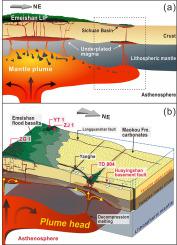Chemical Geology ( IF 3.6 ) Pub Date : 2021-11-19 , DOI: 10.1016/j.chemgeo.2021.120636 Xiaoyu Liu 1, 2 , Nansheng Qiu 1, 2 , Nina Søager 3 , Xiaodong Fu 4 , Ran Liu 1, 2, 5

|
The emplacement of the Late Permian Emeishan large igneous province (ELIP) in the Upper Yangtze craton, SW China, is considered to be a crucial factor that triggered the end-Guadalupian biodiversity crisis. However, the contribution of ELIP remains debated because of its relatively modest known size. The restricted assessment of its areal extent is, in part, due to the lack of study of the potential volcanic rocks concealed beneath younger strata. Here we present the first geochemical and isotopic variations and detailed spatial distribution of Late Permian basaltic rocks penetrated by deep exploratory boreholes in the Sichuan Basin. The Late Permian basaltic rocks are mainly distributed in the western and northeastern parts of the Sichuan Basin and are positioned at the same stratigraphic level as the Emeishan flood basalts. Petrography, whole-rock trace elements and Sr-Nd-Pb isotopic compositions demonstrate that these rocks are alkaline basalts and have oceanic island basalt - like characteristics, indicating a similar origin as the Emeishan flood basalts. The trace element and isotope ratios suggest that the basaltic magmas in the western Sichuan Basin were derived by low degrees of partial melting of a garnet-bearing source. In contrast, the basalts in the northeastern part of the basin were generated by higher degrees of melting of a shallower mantle source in the spinel-garnet transition zone. Varying amounts of contamination by lower continental crustal melts are suggested by rough correlations between isotope and immobile trace element ratios. The spatial changes in composition and origin of the basaltic rocks in the Sichuan Basin can be interpreted as the result of varying extents of Emeishan mantle plume-lithosphere interaction under different lithospheric stress backgrounds, such that the reactivation of pre-existing basement faults controlled the emplacement of basaltic magma in the periphery of the ELIP. Our work reveals a substantially broader extent of the ELIP in buried sedimentary strata, which might have contributed to the abrupt end-Guadalupian climatic change.











































 京公网安备 11010802027423号
京公网安备 11010802027423号